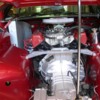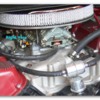Lately I've been frustrated by the car not wanting to re-start after going for a run and then sitting for an hour or two. The only way to get her going again is to push down the go pedal and crank for 3-5 seconds like she's flooded.
So, I took her to a mechanic who has an excellent reputation with the classic mustang guys in my area and when we shut her off and took of the air filter, fuel was shooting out of the air bleeders and after a while we spotted some dripping out the sides of the carb onto the intake, so she was definitely flooding from all of the heat (the fact that the fuel line is currently routed over the top of the intake and next to the valve cover is probably a contributing factor).
So, here's what we're (well, mostly him, with my wallet playing a supporting role) looking at doing over the next few days ...
1) New braided fuel line with insulating wrap running alongside the gas tank, across the engine bay brace and then up to the carb - I hope this doesn't look ugly, but hey, I'd rather lose a few beauty points and save the engine long-term from cylinder wash
2) Block off the exhaust cross over on the intake to reduce heat under the carb (I've read mixed reviews on this one - I don't drive her in the winter, just the warm days April through November)
3) Install a 1" riser under the carb - and a smaller diameter but taller air filter
4) New fuel pump
5) New plugs - gapped to between .45 and .50
So, are we on the right track here, anything more (or less) we should be doing in this situation?
(not sure if any of this matters, but she has the factory fuel pump just now, a Holley 750 HP Pro double pumper with mechanical secondaries, Edelbrock performer intake, and MSD ignition)
Thanks!
Original Post





